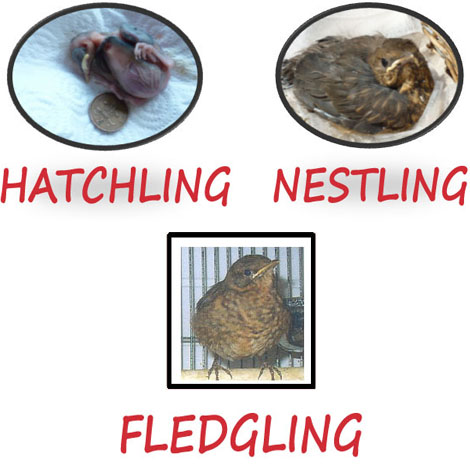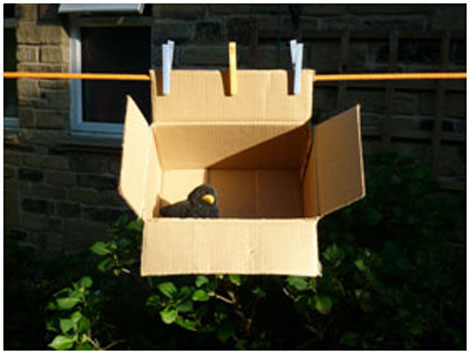- Home
- FAQs
- Customer Video Gallery
- Customer Photo Gallery
- Bird Facts
- Bird Food Blog
- Bird Information
- Feeding Advice
- Small Animal Information
- A to Z of Guinea Pigs
- A to Z of Hamsters
- A to Z of Rabbits
- Basic Care for Guinea Pigs
- Basic Care for Hamsters
- Basic Care for Rabbits
- Basic care for Chinchillas
- Basic care for Ferrets
- Basic care for Gerbils
- Basic care for Mice
- Basic care for Rats
- Buying a Healthy Small Animal
- Does your Reptile need a Licence
- Equipment for Ferrets
- Equipment for Hamsters
- Equipment for Mice
- Equipment for your Chinchilla
- Equipment for your Gerbil
- Equipment for your Guinea Pig
- Equipment for your Rabbit
- Keeping a House Rabbit
- Dog Information
- Cat Information
- Customer Information
- Fat Balls
- Suet Pellets
- Straights
- Seed Mixes
- Suet Treats
- Mealworms
- Bird Feeders
- My Account
Baby Garden Birds - When To Rescue
Date: 2012-06-06 14:20:03 | Category: Bird Protection | Author: Tommi Townsend
This is most dangerous time of year for our garden bird population as it's the mating season. Nests are being built and babies are hatching. Birds of all different species and ages face potential problems and dangers.Thousands of baby birds die needlessly each year because people do not know what to do when they find a baby bird. Should I intervene or should I leave it well alone? These are the typical questions that will run through your brain and the answer will depend on the situation.
Before we can talk of the possible rescuing of birds we need to be aware of what they look like at different ages as this will partially determine what action you need to take, if any.

BABY GARDEN BIRDS - MYTH BUSTER
There is a myth that if you touch a baby bird the parents will reject it as it will smell of humans. What utter rubbish! Birds have a very poor sense of smell and recognise their offspring by its call and not its smell.
The big question, to which I alluded to earlier, is 'What do you do with a baby bird once you've found it?' Sadly, there isn't a stock answer I can give you as each situation will differ. There are, however, some rules to follow which will help you to make the correct decision for your situation. In all rescue cases, however, you should always contact a wild bird rescue for assistance as birds require very specific help.
TO RESCUE OR NOT TO RESCUE - THE RULES
You must never interfere with nature unless it is absolutely necessary. WYAIN often receive telephone conversations from people who mean well but don't really understand the situation that faces them. A fledgling has to learn to fly and so it may look as though it is in difficulty or has been abandoned when in fact it hasn't. Watch carefully and you will usually find that its parents are somewhere close by watching from a good vantage point ensuring that it's safe and not in any danger. Only intervene if the bird needs help.
A bird will need rescuing if...
- It has been caught by a cat. If it has then you must seek help immediately as a cat's mouth contains bacteria which, once in the bird's bloodstream, will result in septicaemia. The bird needs antibiotics quickly otherwise it will die. This is true for any bird of any age.
- It has an obvious injury.
- It is out of the nest and is a hatchling, sometimes called a 'pinkie'. Return it to the nest if at all possible otherwise it will need rescuing.
- A partially feathered bird is out of the nest and there is no sign of its parents for two hours.
- The nest has been destroyed and the birds are not fully feathered.
- Both parents have been killed.
- The baby bird is in immediate danger from a predator, a car or people. Keep the bird safe from danger by using a washing line...
Top Tips
- A hatchling will require feeding every fifteen minutes with moist cat food otherwise it will digest its own stomach. To open the mouth tap on the side of its beak!
- The parents need to see their baby so get a cardboard box and peg it onto a washing line. Place the baby bird in the box and watch to see if the parents come along to claim it. If they don't then the baby bird needs rescuing.

BABY GARDEN BIRDS
Okay, so you have decided that the baby bird needs rescuing...what do you do next?
Working quickly, pop the bird into a secure box with a makeshift nest of kitchen towel and keep the bird warm, an airing cupboard is just perfect, dark and stress free.
Contact a wild bird rescue immediately.
Following these steps will ensure that you are giving the baby bird the very best chance of survival.
Whilst writing this blog I can hear the sound of chain saws in the distance and I'm hoping that trees are not being felled. I'm off to check...watch this space!
Yes, some workmen are felling trees in a nearby garden and I know for a fact that there are nesting birds in these trees. Politely, I asked the workmen if they had checked for nesting birds before felling. 'Yes' they replied. When I pushed them a little bit more it transpired that they checked the trees for nesting birds six weeks ago! I explained that within that time birds had built their nests, had their young and were now busily feeding them. Needless to say they had to stop their illegal felling activities immediately.
Tree felling and hedge trimming should not be undertaken at this time of year as birds are building their nests and are feeding their young. You are actually committing a legal offence, under The Wildlife Order 1985, if you disturb any nesting birds and this includes peering into an active nest. Leave any felling and trimming of trees and hedges until the autumn when all the birds have fledged. Should you have no alternative but to fell trees or trim hedges in the nesting season then you must check the same day for nesting birds and, should you find an active nest, postpone any works until the birds have flown the nest.
For more information about what we do please visit our website www.westyorkshireanimalsinneed.org.uk and follow us on Facebook at West Yorkshire Animals In Need - Official...don't forget to click 'Like'
Bye for now...look out for my next blog!
Tommi Townsend
Co-Founder of West Yorkshire Animals In Need (WYAIN)




